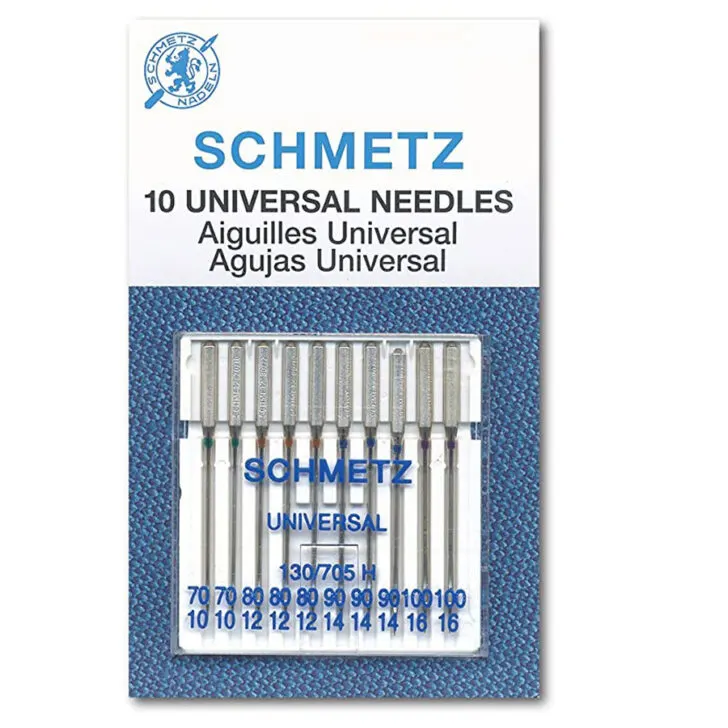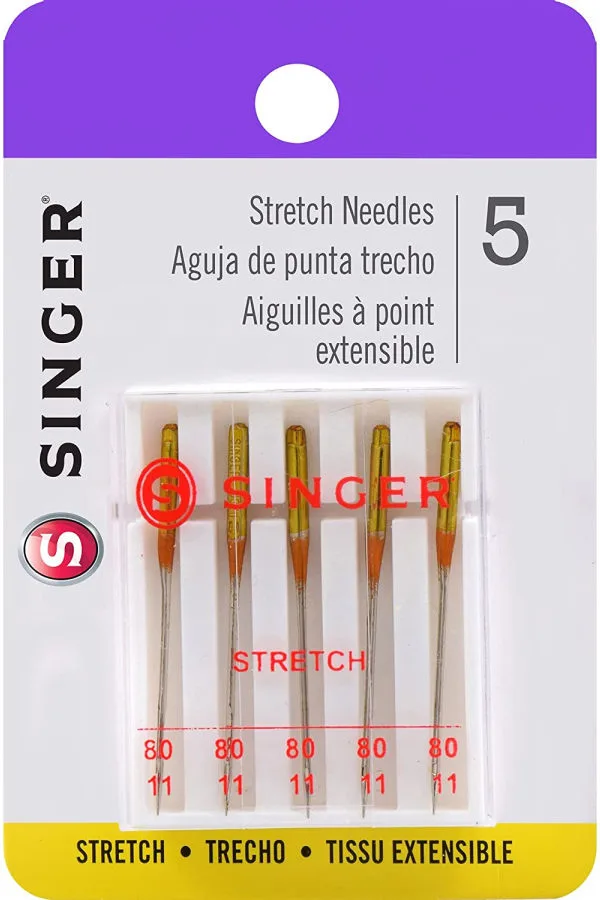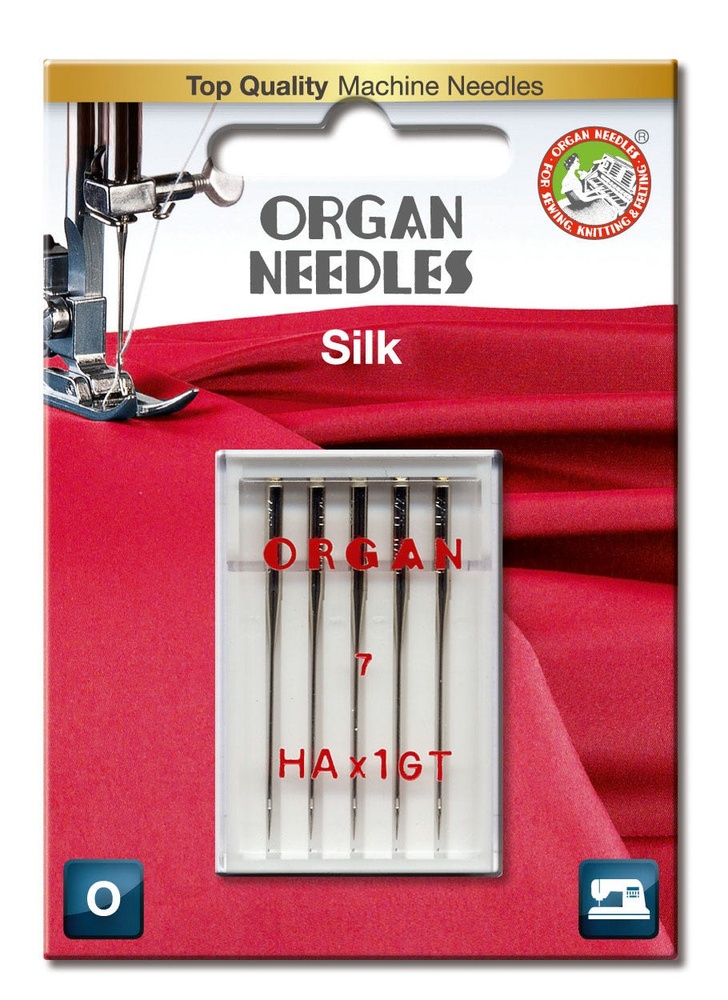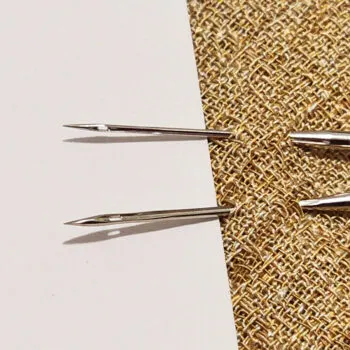Have you ever wondered why there are so many different needle sizes for sewing machines? Or how to know which size to use for which fabric? Sewing machine needles are incredibly important as the wrong size or type of needle can cause skipped stitches, broken thread, and even damage to your fabric. In this tutorial, I’ll explain what the different sizes mean and when to use them.
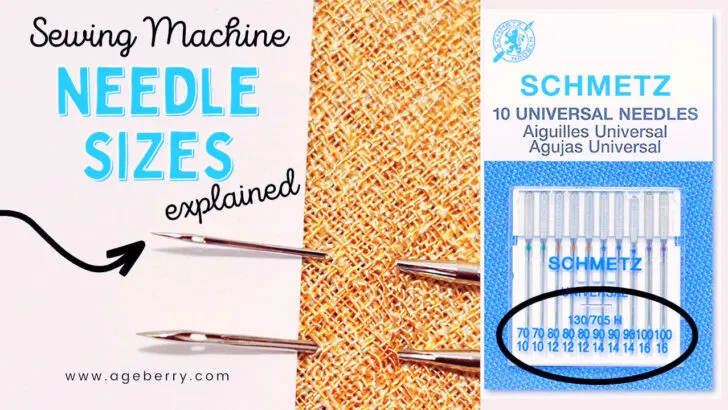
So, here I have Schmetz universal sewing machine needles – look at all these numbers featured on the packaging. What are all these numbers? 70-80-90-100-10-12-14-16. Why so many? What needle should I use for the project?
Note: Some of the links on this page are affiliate links. This means I will receive a commission if you order a product through one of my links. I only recommend products I believe in and use myself.
Looking at those numbers can be quite confusing if you don’t know the difference between them. All those numbers refer to the size of the needle, so it is important to know what they mean.
Sewing Machine Needle Sizes Guide
The two main classifications of sewing machine needles are based on the type and size of the needle.
The type of needle is determined by the specific purpose of your project, such as quilting, embroidery, or leather work. The type of needle tells you what kinds of fabrics work with that needle. For instance, a ballpoint needle or a stretch needle has a rounded point that works well with knit fabrics. I cover the types of sewing machine needles in another article, 19 Types of Sewing Machine Needles and What They’re Used For.
The needle size is another important characteristic. The types of needles have different features, but the sizing simply determines how thick or thin the needle is. In general, the larger the number, the thicker the needle.
The size is in fact simply the thickness of the blade (sometimes also named shaft) of the needle, as in this image:

Is size important? Definitely. Think of sewing machine needles the same way that you think of shoes. Most of us can wear a pair of shoes that are a half size too large or a half size too small. But, I am not going to be as comfortable if I do so. And, if I am wearing too small or too large shoes and I try to do something like play tennis, I’m not going to be very effective. I may trip and fall, or my feet may be in serious pain at the end of the match.
Sewing machine needles are similar. A too large or too small needle might work somewhat, but eventually, the poor fit will cause problems in your sewing.
Different sizes of needles are necessary because different types of fabrics require different levels of penetration from the needle in order to stitch them together properly. For example, thin fabrics like chiffon need thinner needles than heavier fabrics like denim and leather because they require less force to penetrate them. Similarly, thicker fabrics like canvas need thicker needles because they require more force to penetrate them.
Here is a list of the commonly available sewing machine needles according to their size.
- 55/7 – the smallest size needle
- 60/8, 65/9, 70/10 – very fine and thin
- 75/11, 80/12 – lightweight
- 90/14 – medium weight
- 100/16 – heavy weight
- 110/18 – very heavy
- 120/19 – the heaviest needle available to non-commercial sewists
I’m sure many of us have experienced that feeling of curiosity when a needle falls out of the system – and Singer stretch needles can add an extra level of confusion. These needles are size 80/11 instead of 80/12 (as we all used to).
Many home sewists mistakenly believe that the smallest size needle available for their sewing machine is 60/8. In fact, the tiniest needle size you can use in most home machines is 55/7.
How do I know this? I came across the 55/7 size needle unexpectedly in a Canadian fabric store called Fabricland. It was meant to be used on thin fabrics such as silk chiffon or silk charmeuse along with lightweight threads like 100 wt. silk thread.
So, I decided I had to try it out – which turned out to be a great decision! I sewed silk chiffon fabric with a needle size 55/7 and it worked incredibly well. When I took the stitches out (I tried the needle on scrap and wanted to see if the needle left holes in the fabric) – there were no holes left behind in the fabric.
✅ Related tutorial: How to sew silk: types of stitches and seams
Unfortunately, locating this specific size needle is now quite a challenge as they are not readily available for purchase.
The size 55/7 needles I have are Klasse brand, but I found also Organ needles size 55/7 at this link https://www.superiorthreads.com/55-7-silk-needles/p/org-silk-55
What Do Sewing Machine Needle Sizes Mean?
Sewing machine needles are labeled with their size, which is a pair of numbers. Often, there are two numbers on the label for the needle, and these two numbers are separated by a slash. These two numbers are both sizes for the needle, but the first one is the European size (which is in fact international, or metric) and the second one is the American size established by the Singer corporation. European needles range in size from 55 to 120, while American sizing numbers go from 7 to 19, although needles made for industrial machines might fall outside of these ranges.
Manufacturers usually label needles using both numbers. The format for the labeling is most often the same: you’ll see the European number followed by the American number – for example 70/10.
The European designation corresponds to the diameter of the needle in hundredths of a millimeter at a non-reinforced point above the scarf.
Why do we have two different measurement systems? Only people from Singer could explain it since they came up with this arbitrary number system (what does 12 have to do with the actual size of the needle, which is 0.8mm?). But let’s count our blessings, after all, we “only” have two measurement systems, while we have many more needle systems (see below).
My husband has a fascinating tool to measure the most intricate sizes, and I decided to measure the diameter of a Schmetz needle size 80/12. Sure enough, it came in at an impressive 0.8mm!
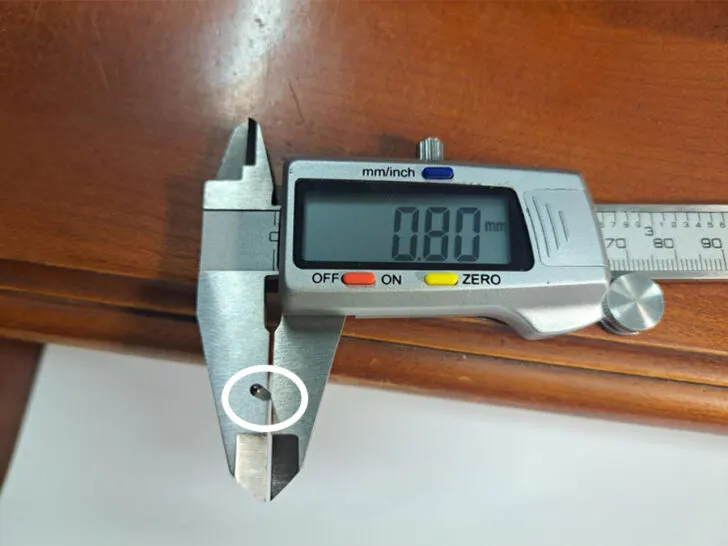
The main thing to remember when you’re shopping for sewing machine needles is this – the higher the number, the thicker the needle. At least here both systems agree!
How Do Sewing Machine Needle Sizes Work?
Let me tell you a story.
My friend brought me her project, a lovely silk scarf, and held it up. The fabric was absolutely gorgeous, but something about the stitching wasn’t right. There were snags and puckers along the delicate hems. In places, the weave of the fine fabric looked messed up and distorted. She said she’d been super careful in pinning the hem, pressing it, and stitching it. So, why was she so disappointed in her project?
I glanced at the scarf and immediately said, “Hey, what kind of sewing machine needle did you have in the machine?”
My friend was confused. The needle was exactly the same as the one she’d always used, why change if it works? The point is exactly that: it doesn’t always work.
I smiled and gently explained, “Most of your stitching has been with heavier weight fabrics. We have your machine set up with a bigger needle for more heavy duty projects. When you want to stitch a delicate fabric, you have to swap out the needle for something more appropriate to the fabric.”
She seemed embarrassed for not realizing something that seemed so obvious in retrospect. She shouldn’t have, we all make mistakes. The point is to learn from them.
“It’s okay,” I reassured her. “I bet we can trim some of this hem off and redo the scarf so it will be perfect. But first, let’s go to the sewing machine store and learn about sewing machine needles so you won’t make this same mistake again.”
While a sewing machine needle’s size indicates how thick or thin the needle is, it also indicates the kind of fabric and thread you should use with that particular needle. If you are sewing a heavy, sturdy fabric, you will need a thicker, heavier needle to puncture the fabric as well as thicker, heavier thread. If you are sewing with a lighter, more delicate fabric and a delicate thread, a thinner, more delicate needle will treat your project with the gentleness it deserves.
Of course, you can probably sew a bit with the wrong size needle for your project, but you are taking a risk. For instance, if you try to sew heavy denim with a thin, lightweight needle, it is quite likely that your needle will bend or snap as you sew. You may experience skipped stitches as the machine struggles to penetrate the fabric. You could even damage the sewing machine because the needle just isn’t up to the task.
Just like with my friend’s scarf sewing project, you can do some sewing with a needle that is too thick for the fabric. However, the project is probably not going to look very good. The needle will leave large holes along the seams, and the weave may be damaged as well. You really could completely ruin a lovely piece of fabric by not matching the needle to the fabric. Don’t make this mistake!
There is another consideration, very important: thicker needles are meant for thicker threads, they have a larger eye to accommodate that thread. You also should match the thread to the needle and fabric. Use lightweight thread for lightweight fabric and thin needles. Use heavier thread for heavy fabric and large needles.
✅ Related tutorial: Sewing thread sizes and how to choose
What Is The Difference In Sewing Machine Needle Sizes
Sewing machine needle sizes differ in how thick or thin the needle is and how sturdy the needle is made. Needles with a high number are thicker and designed to hold up to tough, heavy fabrics without snapping. These big needles also have larger eyes to manage heavier threads that you’ll need for these heavy fabrics. Needles with smaller numbers are suited for delicate fabrics with thinner shanks and smaller eyes.
Sewing Machine Needle and Thread Size
Just like you wouldn’t wear heavy wool hiking socks with a pair of ballet slippers, you also have to match your thread to your fabric and your needle size.
Just like needles, thread is also numbered to indicate how heavy the thread is. The weird and kind of confusing thing is this – thread weight numbers actually work the opposite way that needle sizes work.
Thread numbers are smaller for heavier threads and bigger for lighter weight threads. For instance, a 30 weight thread is thicker than a 100 weight thread. You should definitely match the thread to the fabric and the needle. When you don’t do this, your thread will likely not feed as well through the needle and your project will not go as smoothly. Below are some suggested needle and thread pairings.
- A 55/7 needle (if you have it) pairs with 100 weight silk thread (if you can find it)
- A 60/8 needle pairs with 100 weight thread
- A 70/10 needle pairs with 50 weight threads
- A 80/12 needle pairs with 50 or 40 weight threads
- A 90/14 needle pairs with 40 weight threads
- A 100/16 needle pairs with 30 weight threads and thicker
Sewing Machine Needle Sizes for Different Fabrics
When you’re choosing what size needle to use, just simply match the needle to the fabric and thread that you are using. Here is a guide to help you decide what you will need. If the kind of fabric you’re using isn’t listed, just try to match the weight of your fabric to one of the listed kinds.
- 60/8, 65/9, 70/10 – These needles are very fine, thin needles that are suited to very delicate fabrics such as fine lace, chiffon, georgette, organza, or lightweight silk.
- 75/11, 80/12 – These needles are lightweight, suited to somewhat lightweight fabrics like voile, silk, cotton, lightweight wool, linen, etc.
- 90/14 – This size of this needle is considered medium weight. This needle will allow you to sew on a wide variety of medium weight fabrics like quilting cotton, velvet, corduroy, linen, muslin, many types of knits, fleece, etc.
- 100/16 – This kind of needles is considered heavy weight. You can sew denim, canvas, leather, coat wool, corduroy, faux fur, etc. with this kind of needle.
- 110/18 – This is a very heavy needle and is suited for sturdy, thick fabrics like heavy denim, upholstery fabric, heavy canvas, or faux fur fabric.
- 120/19 – This is the heaviest needle available for non-industrial use. You can use it for any fabric that is heavier than the above listed fabrics.
It’s important to note that these sizes are just a guideline; if you find that your stitches aren’t quite right with a particular needle size, try switching it up until you find one that works well with your fabric.
There are other kinds of much heavier needles available for commercial sewing. You can get industrial sewing machine needles that are 130/21 up to 300/29.
I love to sew with natural silk and one thing I’ve learned over the years is that while working with silk fabric, the needle for silk fabric matters. A wrong needle can leave traces of punctures in the fabric — something we want to avoid when working with delicate silk fabric.
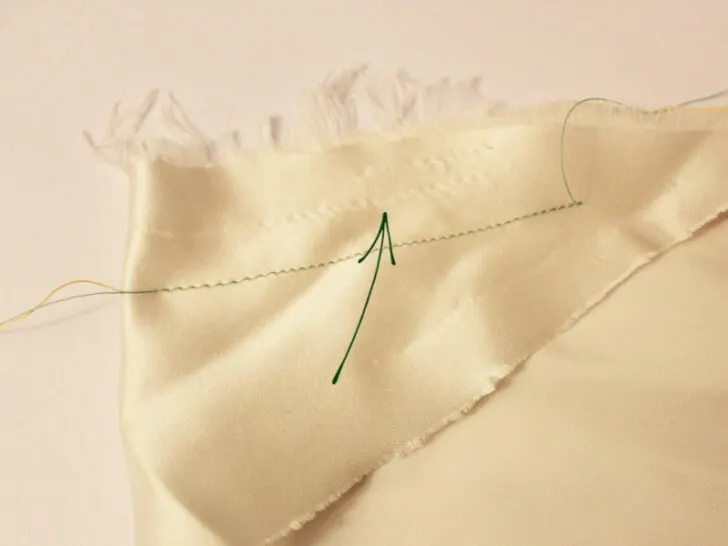
Use a thin universal or sharp sewing machine needle for silk – 70/10, 65/9, and 60/8 size needles are great for different types of silk.
While there are many needle sizes, all types of needles are not available in all sizes.
- Machine embroidery needles are available in sizes 75/11, 80/12, and 90/14.
- Jean/denim needles are available in sizes 90/14, 100/16, and 110/18.
- Ball point needles are available in sizes 70/10, 75/11, 80/12 and 90/14.
- Stretch needles are available in sizes 65/9, 75/11, 80/12 and 90/14.
- Self threading needles are available in sizes 80/12 to 90/14.
- Leather needles are available in sizes 80/12, 90/14 and 100/18.
- Metallic needles are available in size 80/12.
- Topstitching needles are available in sizes 80/12, 90/14, and 100/16.
- Wing needles are available in sizes 100/16 and 120/19
- Universal needles are available in most sizes.
✅ Related tutorial: The Ultimate Guide to Stretch Needles
Sewing Machine Needle Eye Sizes
The size of the eye of the sewing machine needle isn’t something that you have to worry about. The manufacturer matches the eye of the needle to the size of the needle. The bigger the needle, the bigger the eye. If you’re struggling to thread a tiny eye in your sewing machine needle, you can use a threading tool or get a self-threading needle that features a slot on the side, making it easier to thread.
Color Codes for Sewing Machine Needle Sizes
You may have noticed some color coding on your sewing machine needles. One thing to remember is that these colors are not standard across manufacturers. But, if you always buy the same brand of sewing machine needles, you will quickly learn the color coding patterns.
For instance, in both Singer and Schmetz brand needles, there are two color bands. The top band indicates needle type and the bottom color band indicates needle size. However, their color choices are different, so check the manufacturer’s website to make sure that you understand their color coding methods.
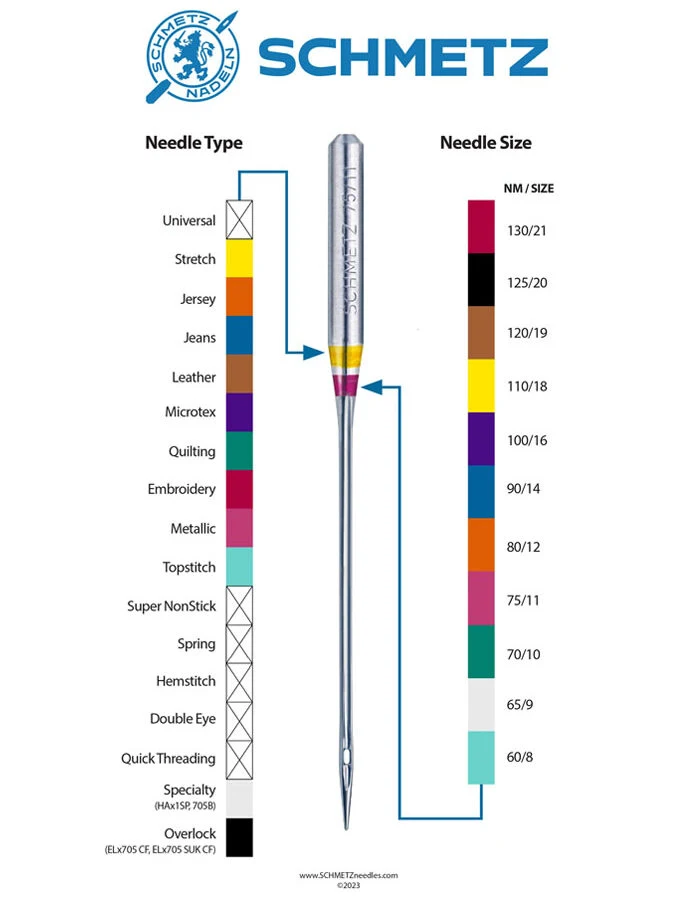
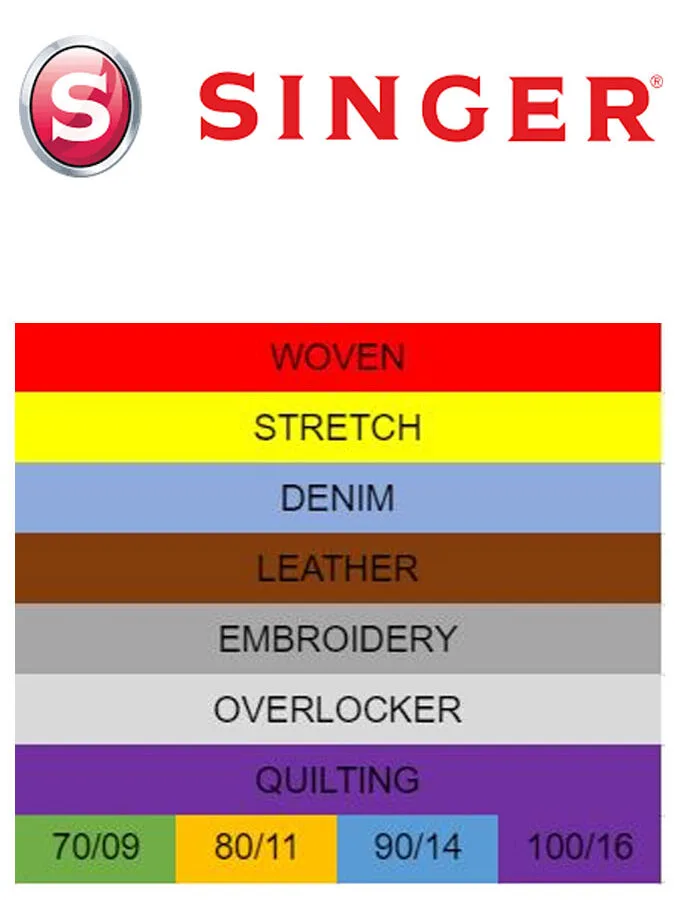
Sewing Machine Needle Systems
If you look closely at the package with Schmetz needles in the image at the beginning of this article, you will notice a number that accompanies the sizes of the needle. This number is 130/705H. What is that? Is it another needle size?
This is the needle system and in general, refers not to the needle size but to various characteristics of the needle that allow it to be mounted in the machine needle holder. Not all sewing machines use the same needle system. My Janome and Brother machines use one type of needle which is labeled in many ways, depending on the manufacturer: Organ HAx1, Schmetz 130/705H Janome 15×1, Singer 2020 and I probably omitted some other designations.
Some of my sergers also use this needle system, but I have one serger ( a Babylock) which uses needles ELx705. The two needle systems (HAx1 and ELx705) are not the same even if with the naked eye one can not see the difference. Even if you are able to fit one needle of the wrong type in the machine you can rest assured that the machine will not work correctly. It might not work at all, in fact.

Always read the user manual for your machine to determine what kind of needle system that particular machine takes and always make sure you properly label the needles if you happen to need both types of needles.
And in case you wonder, yes, it has happened to me, to try to fit the wrong needle in the machine! But I have a very simple solution for this. You see, when you take the needle from the manufacturer’s package, there is a large label on the package with both the needle system and its size. But what happens when you need to change the needle, but want to reuse it later? Because, for example, you need to sew a thicker material for a while.
In these situations, I put the slightly used (but still good) needle in my needle book described in this article: Adorable DIY Needle Book | Easy Tutorial for Beginners. This is an excellent project for beginners and advanced sewing enthusiasts equally. Not only will you get to practice sewing, but you will also get a very useful tool (the book itself) and you will use in the process some scraps which otherwise would have been thrown away.
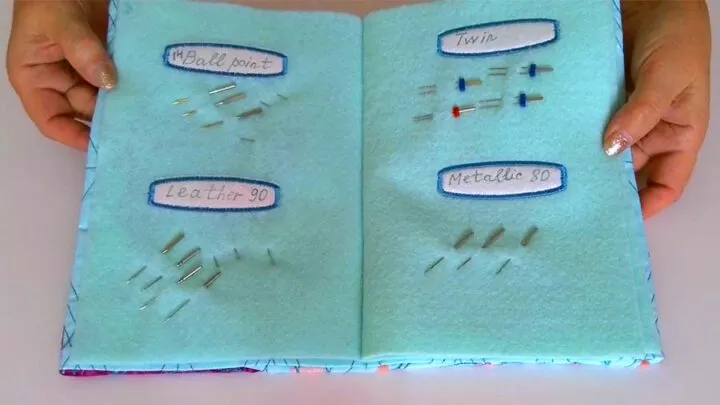
Heavy Duty Sewing Machine Needle
If you do a lot of heavy sewing, like with jeans or maybe making purses and bags, you may want to buy a package of heavy duty needles. For instance, this package may contain 90/14, 100/16, and 110/18 needles. These needles are not only thicker than many other needles, they are also designed for heavy duty sewing, featuring bigger eyes for heavier thread and a sturdier shank to hold up to serious stitching.
Twin Sewing Machine Needle Sizes
Twin sewing machine needles feature two needles connected by a bar to create a double line of stitching. These needles can vary in size just like any other kind of needle, but you also have to consider the length of the bar that connects them. The bar can range in length from 1.6 millimeters to 8 millimeters. If you need more information on twin needles, check out my article Everything You Need to Know About Sewing With a Twin Needle.
Sewing Machine Needle Length
Although hand sewing needles vary in length, sewing machine needles are all basically the same length, regardless of the size. This is because the machine has to work in the same way, regardless of how thick the needle is. This is a relief because it is one less thing that you have to consider as you sew.
FAQ
How To Identify Sewing Machine Needle Sizes If You Can’t Read The Imprints
Most sewing machine needles have the size engraved on the top of the needle.
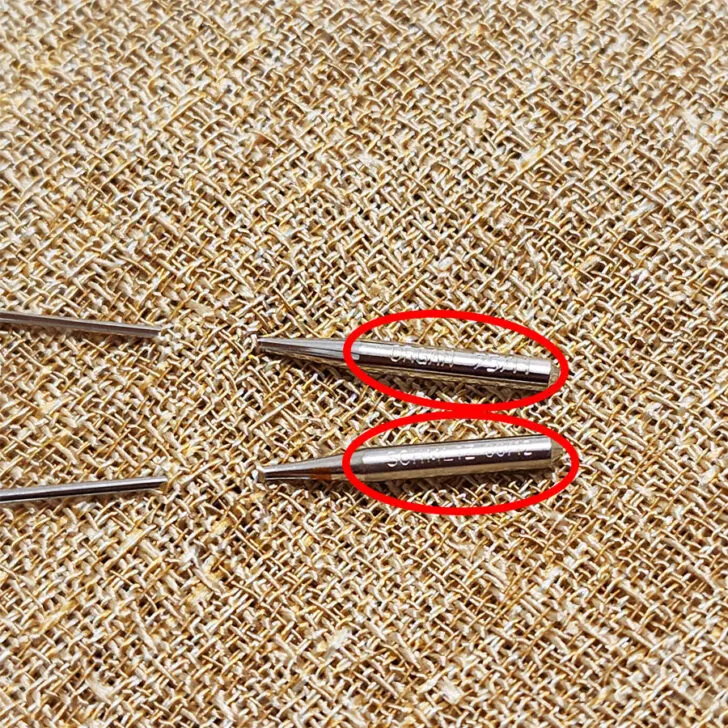
If you found a random needle in your pincushion and you can’t read the numbers, find a sharp-eyed friend to figure out what you have.
However, these numbers are incredibly tiny and if you don’t have very sharp eyes or a handy friend, you may need a magnifying glass to read them, as I do. I own both the ones below and I find the one with light very, very handy.
If your needle is coming right out of the package, you can just note the label on the package.
When you take the needle out of the machine, you can use a piece of masking tape to label your needle so you do not forget what size it is.
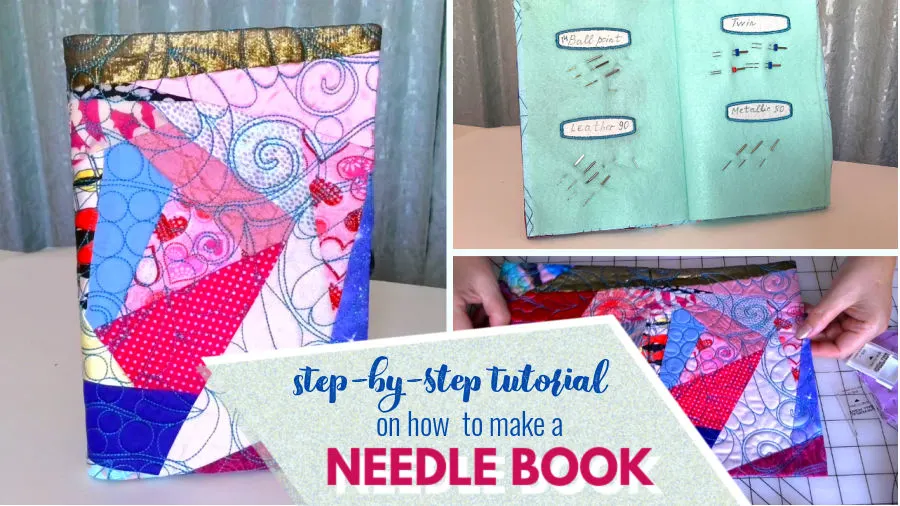
Or you can use some of your fabric scraps and make a fancy needle book to keep your needles sorted according to size and purpose.
What Size Sewing Machine Needle For Cotton
It depends what type of cotton you are using for your project. For quilting cotton – use a universal needle size 80/12 or 90/14.
For cotton voile and cotton lawn which are very lightweight fabrics, almost transparent, use a universal or sharp needle size 75/11 or 70/10.
For cotton twill which is heavy weight fabric use a universal needle size 90/14 or even 100/16.
Sewing Machine Needle for Thick Fabric
Different thick fabrics, like denim, wool and corduroy, all have different thicknesses, so it’s important to select the correct needle from the start. If you’re working with thinner denim try a 90/14 needle, however heavier fabrics may require a 100/16 or even 110/18 size needle. Coat wool fabric and felt usually call for a 100/16 universal needle while corduroy most often requires an admittedly thinner 90/14 one. Faux fur is also made up of varying thicknesses and may require either the 90/14 or 100/16 universal needle – for really thick variation even the 110/18 might be needed.
Knit fabrics can be thick also – use 90/14 or 100/16 size needles for fleece, thick velvet and sweatshirt fabrics.
What Size Sewing Machine Needle For Vinyl
It depends… When choosing the right size needle for vinyl, it is important to keep in mind that larger needles create larger holes in your vinyl fabric so if you want to avoid visible holes in your finished project then it is best to opt for smaller sized needles. In general, when working with vinyl material you should use either an 80/12 size needle (for light-weight vinyl) or 90/14 needle (for medium weight vinyl). If you use marine vinyl or other types of heavy weight vinyl, you may need a 100/16 needle.
✅ Related tutorial: Sewing Vinyl: 17+ Expert Tips For Beginners
Sewing Machine Needle Sizes For Quilting
When choosing a needle for quilting projects, it’s important to consider what type of fabric you’ll be using before selecting a size of needle.
There are several factors to consider: fabric weight (lightweight or heavyweight), fabric type (woven or knit), thread type and the machine you are using for quilting. Generally speaking, lightweight fabrics like silk require smaller size needles (70/10 – 80/12) while heavyweight fabrics like denim should use larger size needles (90/14 – 110/18). If you use quilting cotton fabric – a 80/12 or 90/14 quilting needle should be good.
While it can be helpful to go by the suggested size as a guideline, don’t be afraid to adjust if you find you’re experiencing difficulties. If you feel like your stitches aren’t quite right, try switching up sizes until you find the one that best complements your fabric.
Did you find this tutorial helpful? If so, save this pin (see below) on your sewing board so you can come to this tutorial later when you need this information on sewing machine thread sizes, and follow me on Pinterest for more tips, tutorials, and inspiration!
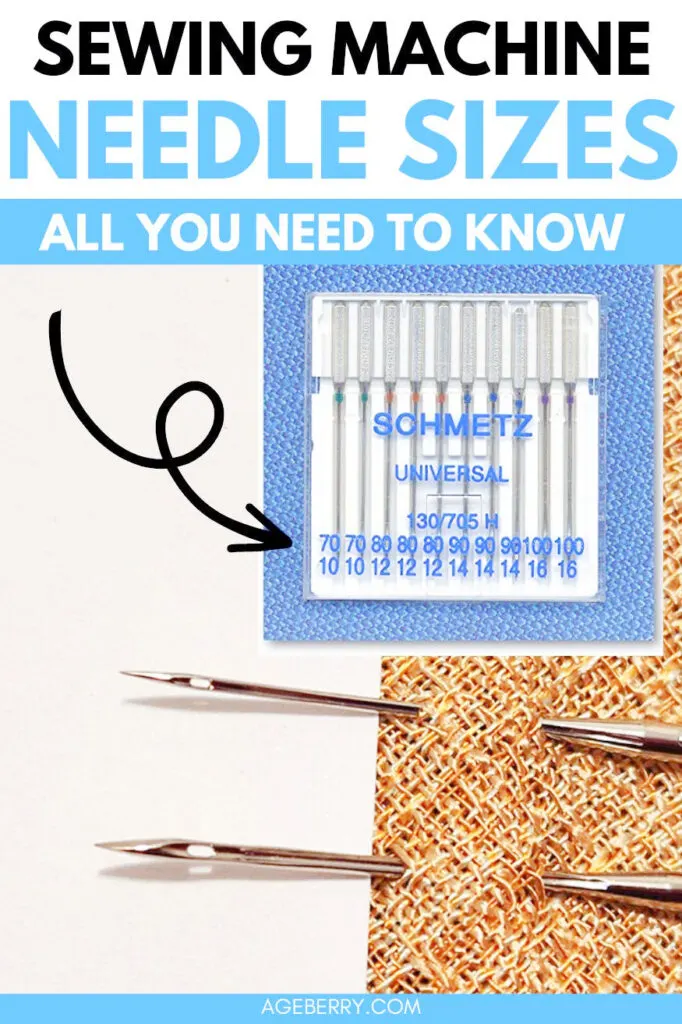
latest posts
- Knot a Problem: Easy Ways to Secure Short Thread Ends
- Ever Tried This on Your Serger? This Differential Feed Feature Will Amaze You
- Ditch My Sewing Machine? Not in This Lifetime!
- Adorable DIY Needle Book | Easy Tutorial for Beginners
- Master the Seam Ripper: Your Ultimate Guide to Precision Stitch Removal
- Think You Know Zippers? This Installation Guide Might Surprise You
- Why Does Your Seam Ripper Have a Red Ball? Discover Its Purpose!
- Topstitching Troubles? This Simple Trick Will Turn It Around Instantly!
- How to Sew Shirring: A Step-by-Step Guide to Elastic Thread Gathering

